 |
Home | Charity | Feedback |
India: Tamil Nadu:
Coonoor,
Mahabalipuram,
Ooty,
Srirangam [Tiruchirapalli],
Thanjavur,
Yercaud
Mahabalipuram, India: Just monolithic by Prakash Bang, Editor in Chief 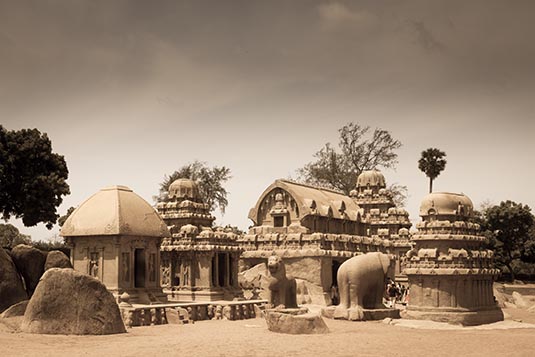 Officially called Mamallapuram, Mahabalipuram can well be called an open-air museum. The town is dotted with rock-cut caves, temples made from a single rock and many bas-reliefs which are sheer works of art. 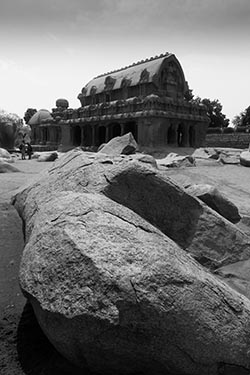 I was on a holiday with my family in the region. We took a detour to Mahabalipuram from Pondicherry on our way to Vellore. Mahabalipuram is about 90 kms from Pondicherry.
I was on a holiday with my family in the region. We took a detour to Mahabalipuram from Pondicherry on our way to Vellore. Mahabalipuram is about 90 kms from Pondicherry.
Mahabalipuram was named after a very rude & cruel King Mahabali who reigned this place and in a fierce battle King Mahabali was killed by Lord Vishnu. It was during the reign of King Narasimha Varman I, the name Mahabalipuram was changed. It was later renamed Mamallapuram. King Narasimha Varman I was a great and valiant warrior. He was given the title Mamalla which means ‘the great wrestler’, thus the name which stands till date. We reached Mahabalipuram just before noon. The few hours that we had on hand would be spent visiting the town’s many monolith structures. The Five Rathas (Chariots): It’s a set of magnificent monolithic rock temples. These fine rock temples are located in a sandy compound. These Five Rathas are the perfect examples of the evolution of Dravidian style architecture. They are built in the shapes of pagodas and look similar to that of the Buddhist shrines and monasteries. These chariots are constructed with towers, multi pillared halls and sculptured walls which have been carved out minutely. The Rathas have an association to the great epic Mahabharata which describes the heroes of Mahabharata with their wife Draupadi. The structures are termed as Pancha Pandava Rathas. Panch is a Hindi world which means ‘Five’. The five Rathas are (i) Draupadi’s Ratha, (ii) Arjuna’s Ratha, (iii) Nakul – Sahadev’s Ratha, (iv) Bhima’s Ratha and (v) Yudhishthira’s Ratha. 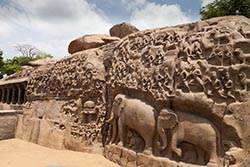 The Mahishamardini Mandapam: Scenes from the Puranas (Sanskrit stories dating from the 5th century AD) are depicted in this cave with the sculpture of the Goddess Durga considered one of the finest. Above the mandapam are the remains of the 8th-century Olakkannesvara Temple and a lighthouse that offer spectacular views of Mamallapuram and the coast.
The Mahishamardini Mandapam: Scenes from the Puranas (Sanskrit stories dating from the 5th century AD) are depicted in this cave with the sculpture of the Goddess Durga considered one of the finest. Above the mandapam are the remains of the 8th-century Olakkannesvara Temple and a lighthouse that offer spectacular views of Mamallapuram and the coast.
Krishna Mandapam: This is the biggest among the mandapams and is dedicated to Lord Krishna. Lord Krishna is a famous legend who has been the figure of many mythological stories. The sculptures inside this mandapam beautifully depict the myth of Lord Krishna during his brave and energetic adulthood. He lifted the huge Mount Govardhana to provide shelter to his people and their animals from torrential rain - created by Lord Indra, the God of rain. 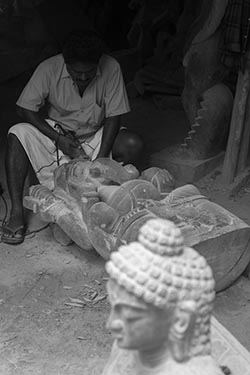 Arjuna's Penance: Also known as Bhagiratha (a sage who brought Ganges to the earth) carvings. This relief carving on the face of a huge rock depicts animals, deities and other semi divine creatures as well as fables from the Hindu Panchatantra books. The panel is divided by a huge perpendicular fissure that's skilfully encompassed into the sculpture; originally, water, representing the Ganges, flowed down it. It's one of the most convincing and unpretentious rock carvings in India, with the main relief showing Shiva standing with a wizened Arjuna, balanced on one leg in a state of penance.
Arjuna's Penance: Also known as Bhagiratha (a sage who brought Ganges to the earth) carvings. This relief carving on the face of a huge rock depicts animals, deities and other semi divine creatures as well as fables from the Hindu Panchatantra books. The panel is divided by a huge perpendicular fissure that's skilfully encompassed into the sculpture; originally, water, representing the Ganges, flowed down it. It's one of the most convincing and unpretentious rock carvings in India, with the main relief showing Shiva standing with a wizened Arjuna, balanced on one leg in a state of penance.
Varah Mandapam: This is a fine piece of architecture. The entrance has two pillars engraved with two horned lion – bases, and a cell protected by two gate keepers. There are four striking bas-reliefs, the northern one with Lord Vishnu (Varaha – the mighty boar) standing on one feet on top of Naga, the snake king. He is rescuing Prithvi, the Goddess earth from the primordial ocean. Krishna's Butter Ball: There is a hill slope near the Ganesh Ratha and on it is a huge boulder. This is amazing as it is in its natural position. This is known as Krishna’s Butter Ball. The Pallava kings tried to move the boulder with elephants but were unsuccessful. 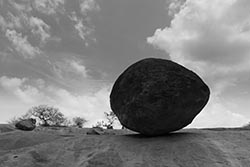 The Shore Temple: Standing like a magnificent fist of rock-cut elegance overlooking the sea, the Shore Temple symbolises the heights of Pallava architecture and the maritime ambitions of the Pallava kings. Its small size belies its excellent proportion and the supreme quality of the carvings, many of which have been eroded over time. Originally constructed in the 7th century, it was later rebuilt by Narasimha Varman II and houses two central shrines of Shiva. The layout is meant to resemble the perfect cosmic body, with the head and heart located over the spire that dominates the structure. Facing east and west, the original linga (phallic images of Shiva) captures the sunrise and sunset. The temple is believed to be the last in a series of buildings that extended along a since submerged coastline.
The Shore Temple: Standing like a magnificent fist of rock-cut elegance overlooking the sea, the Shore Temple symbolises the heights of Pallava architecture and the maritime ambitions of the Pallava kings. Its small size belies its excellent proportion and the supreme quality of the carvings, many of which have been eroded over time. Originally constructed in the 7th century, it was later rebuilt by Narasimha Varman II and houses two central shrines of Shiva. The layout is meant to resemble the perfect cosmic body, with the head and heart located over the spire that dominates the structure. Facing east and west, the original linga (phallic images of Shiva) captures the sunrise and sunset. The temple is believed to be the last in a series of buildings that extended along a since submerged coastline.
Whilst touring from cave to another, we had the opportunity to see scores of craftsmen carving hard granite into intricate murals and statues of various Gods and Goddesses. The town is a major source of granite carvings. The produce are sold nationally and exported as well. With hours beautifully spent, we moved towards Vellore. Mahabalipuram Image Gallery  Photo viewer Photo viewer
|
|
|
Home |
Charity |
Feedback
Privacy Policy | Terms of Usage © YoGoYo.com. All rights reserved. |











